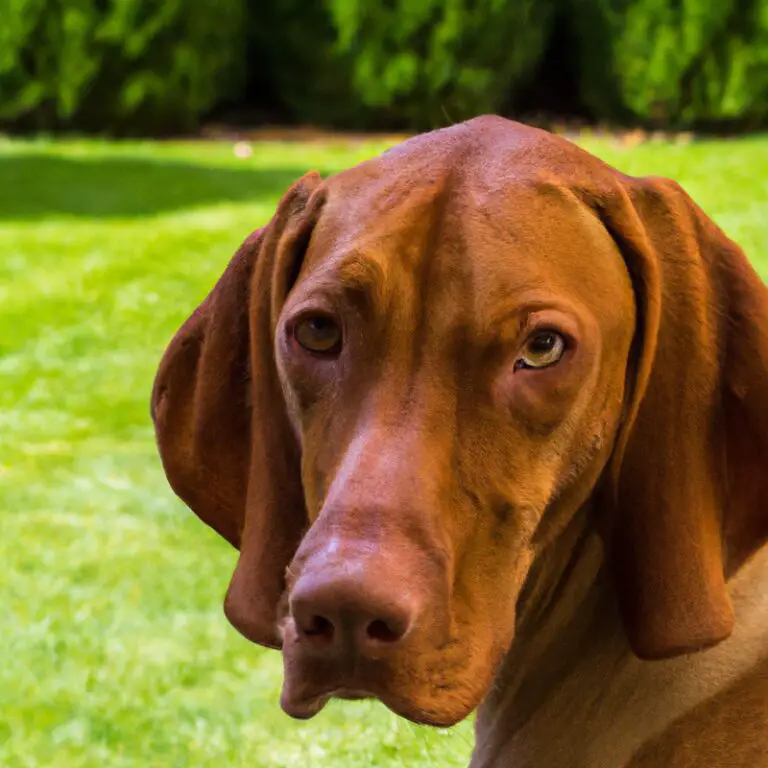What Are Some Signs Of Potential Aggression In Vizslas And How To Address It?
Key Takeaways:
- Vizslas may show signs of potential aggression through growling, stiff body language, and raised hackles.
- Addressing potential aggression in Vizslas requires consistent training, socialization, and positive reinforcement techniques.
- Early intervention and professional help may be necessary to prevent aggression issues from escalating.
Are you a proud Vizsla owner?
These beautiful, energetic dogs are known for their affectionate and friendly nature.
However, like any breed, Vizslas can display signs of aggression if not properly managed.
In this article, I’ll be diving into the signs of potential aggression in Vizslas and providing you with some practical tips on how to address it.
From body language clues to resource guarding behavior, we’ll explore the warning signs and discuss the importance of early socialization, seeking professional help, and using positive reinforcement techniques.
So, let’s ensure a peaceful and harmonious relationship with our beloved Vizslas!
| Signs of Potential Aggression |
| 1. Bared teeth and growling 2. Snapping or lunging 3. Stiff body posture 4. Raised fur on the back 5. Direct, intense staring 6. Prolonged or excessive barking 7. Blocking or guarding behavior |
Signs of Potential Aggression in Vizslas
Body language clues of aggression in Vizslas
Dogs communicate primarily through body language, and Vizslas are no exception.
When it comes to aggression in Vizslas, it’s important to be able to recognize the clues they might display.
Here are some body language signs that could indicate aggression in Vizslas:
- Stiff body posture: If your Vizsla becomes rigid and tense, with a stiff body and erect tail, it may be a sign of aggression.
- Raised hackles: When the fur along their back and shoulders stands on end, it often indicates that a dog is feeling threatened or aggressive.
- Direct staring: Intense and unwavering eye contact can be a form of dominance or aggression. Pay attention if your Vizsla starts fixating on something or someone with a locked gaze.
- Snarling or growling: Vizslas may show their teeth, emit low growls, or snarl when they feel threatened or challenged.
- Lip licking or yawning: These subtle signs can signal stress or anxiety, which can potentially escalate into aggression if the situation doesn’t diffuse.
Remember, if you notice any of these body language clues in your Vizsla, it’s important to address the situation calmly and take appropriate measures to keep everyone safe.
Seeking guidance from a professional dog trainer or behaviorist can also be valuable in understanding and managing aggression in Vizslas.

Growling, snarling, and barking
Vizslas may display growling, snarling, and barking as signs of potential aggression. These behaviors can indicate that your dog feels threatened or uncomfortable in a situation.
It’s important to address these signs early on to prevent any escalation.
Here are some steps you can take to address these behaviors:
- Identify triggers: Pay attention to what triggers your Vizsla’s growling, snarling, or barking. It could be certain people, other dogs, or specific environments.
- Train and socialize: Proper training and socialization are key. Teach your Vizsla basic commands and expose them to different situations from a young age. Positive reinforcement-based training can help establish boundaries and build confidence.
- Seek professional help: If the aggressive behaviors persist or escalate, consult with a professional dog behaviorist or trainer. They can provide guidance on managing and modifying your Vizsla’s behavior effectively.
- Provide a safe environment: Create a safe and comfortable environment for your Vizsla. Avoid exposing them to situations that trigger aggression and ensure they have a designated space where they can retreat if they feel overwhelmed.
Remember, addressing potential aggression in Vizslas requires patience, consistency, and understanding. By taking proactive steps and seeking professional guidance if needed, you can help your Vizsla become a well-adjusted and happy companion.
Resource guarding behavior
Resource guarding behavior in Vizslas is when they show possessive or protective behavior over their belongings.
This can include toys, food, or even their human family members.
Some signs of resource guarding may include growling, snapping, or lunging when someone approaches their possessions.
It’s important to address this behavior to ensure safety and prevent potential aggression.
Professional training and behavior modification techniques, such as positive reinforcement and desensitization, can help manage and reduce resource guarding tendencies in Vizslas.
Always consult a qualified professional for guidance and support.

Fearful or defensive behavior
Fearful or defensive behavior in Vizslas can be displayed through certain signs.
These may include growling, barking excessively, cowering, hiding, or showing signs of aggression such as lunging or snapping.
It’s crucial to address these behaviors promptly to prevent them from escalating.
To do so, focus on creating a positive and safe environment, socializing your Vizsla with other people and dogs, using positive reinforcement training techniques, and seeking professional help if necessary.
Remember, patience and consistency are key in addressing and managing fearful or defensive behavior in your Vizsla.
Addressing Aggression in Vizslas
Importance of early socialization and training
Early socialization and training are essential for Vizslas to develop into well-rounded and balanced dogs. It helps them become comfortable and confident in a variety of environments and situations.
By exposing them to different people, animals, and experiences, you can prevent fear and aggression issues later on.
Start socializing your Vizsla as soon as possible, introducing them to new sights, sounds, smells, and interactions. Consistency and positive reinforcement training methods are key to shaping their behavior and ensuring they grow up to be happy, friendly companions.

Seeking professional help
If you notice signs of aggression in your Vizsla, seeking professional help is essential. A qualified animal behaviorist or trainer can assess your dog’s behavior and develop a customized plan to address the aggression.
They will provide guidance on training techniques and management strategies to help modify your Vizsla’s behavior.
Working with a professional will ensure that you receive expert advice and support throughout the process. Remember, getting professional help early can greatly improve your Vizsla’s behavior and overall well-being.
Positive reinforcement techniques
Positive reinforcement is an effective technique for addressing aggression in Vizslas.
Here are some techniques to use:
- Reward good behavior: Whenever your Vizsla displays calm and non-aggressive behavior, reward them with praise, treats, or playtime.
- Redirect their focus: If you notice signs of aggression, redirect their attention to something more positive, like a toy or a command they know well.
- Consistency is key: Be consistent with your training and rewards. This will help reinforce the desired behavior and discourage aggression.
- Socialize your Vizsla: Expose them to various people, animals, and environments from a young age to build their confidence and reduce the likelihood of aggression.
- Seek professional help if needed: If your Vizsla’s aggression persists or worsens, consult a professional dog trainer or behaviorist who specializes in positive reinforcement techniques. They can provide personalized guidance and support.
Remember, always use positive reinforcement techniques instead of punishment to create a happy and well-behaved Vizsla.
Consistency and establishing boundaries
Consistency and establishing boundaries are key when addressing aggression in Vizslas.
By setting clear rules and consistently enforcing them, you can create a structured environment that helps prevent aggressive behavior.
It’s important to establish boundaries from the start and ensure everyone in the household follows them.
This includes setting limits for physical contact, playtime, and resource guarding.
Consistency in training, socialization, and positive reinforcement also plays a critical role in shaping your Vizsla’s behavior.
Frequently Asked Questions about Aggression in Vizslas
How common is aggression in Vizslas?
Aggression in Vizslas is not uncommon, but it’s important to remember that not all Vizslas are aggressive. Some individuals may display signs of aggression due to genetic predisposition, improper training, fear, or other factors.
It’s crucial for owners to understand the signs of potential aggression and consult with a professional trainer or behaviorist to address any concerning behaviors.
Socialization, obedience training, and positive reinforcement are key in preventing and managing aggression in Vizslas.
Can aggression in Vizslas be completely eliminated?
Aggression in Vizslas cannot be completely eliminated, but it can be managed and minimized with appropriate training, socialization, and positive reinforcement techniques. A key aspect is identifying and addressing triggers early on.
It’s important to work with a professional dog trainer to develop a personalized plan that focuses on redirecting and modifying your Vizsla’s behavior.
Consistency, patience, and ongoing training are crucial for long-term success.
Is neutering or spaying a solution for aggression in Vizslas?
Neutering or spaying a Vizsla can help reduce aggressive behaviors in some cases but is not a guaranteed solution.
It may decrease hormone-related aggression and territorial behavior.
However, factors such as genetics, socialization, and training also play a significant role.
It’s essential to consult with a veterinarian or professional dog trainer to develop a comprehensive approach to address aggression in Vizslas.
How long does it take to address aggression in Vizslas?
Addressing aggression in Vizslas can vary in duration depending on the individual dog and the severity of the aggression.
It can take anywhere from a few weeks to several months to see improvements.
Consistency in training and behavior modification techniques is key.
Working with a professional dog trainer or behaviorist can help speed up the process and ensure the best results.
Patience and commitment are essential when addressing aggression in Vizslas.
Final Verdict
As a canine behavior expert, I have discussed the signs of potential aggression in Vizslas and provided effective ways to address it. Understanding the body language clues such as growling, snarling, and barking, as well as resource guarding and fearful behavior, can help identify aggression in Vizslas.
Early socialization and training, seeking professional help, using positive reinforcement techniques, and establishing consistent boundaries are crucial in addressing aggression.
While aggression in Vizslas can be challenging, with patience and dedication, it can be managed and reduced. Remember, professional guidance and a proactive approach are key to helping your Vizsla become a well-behaved and balanced companion.







